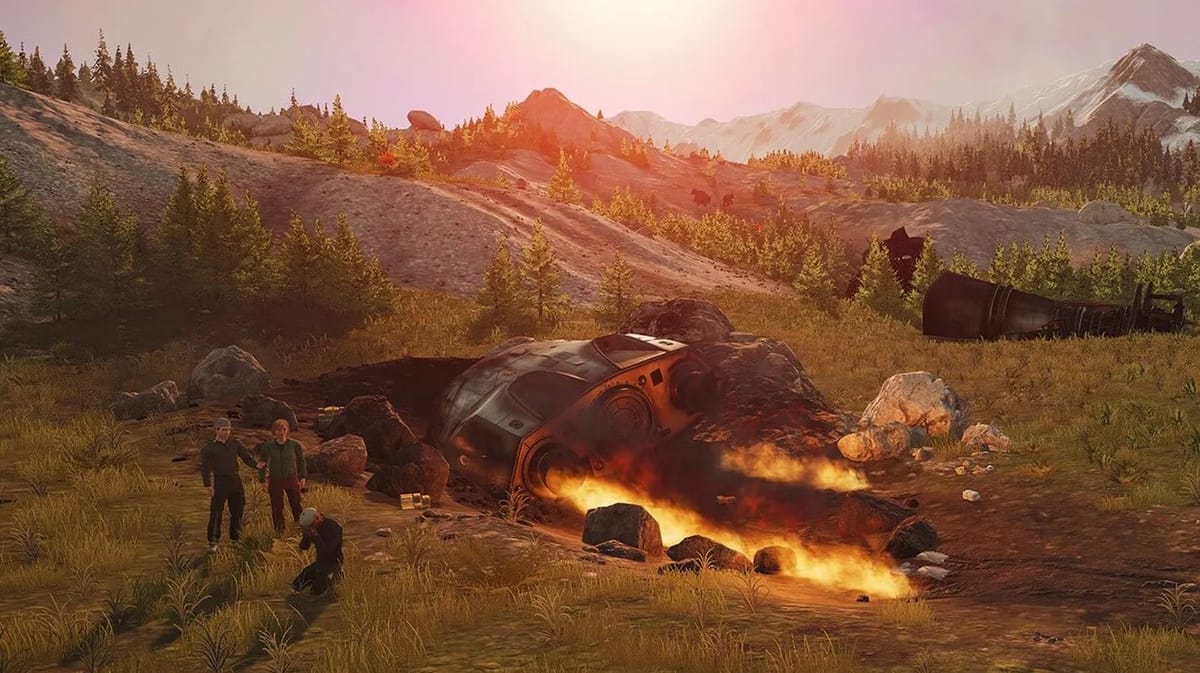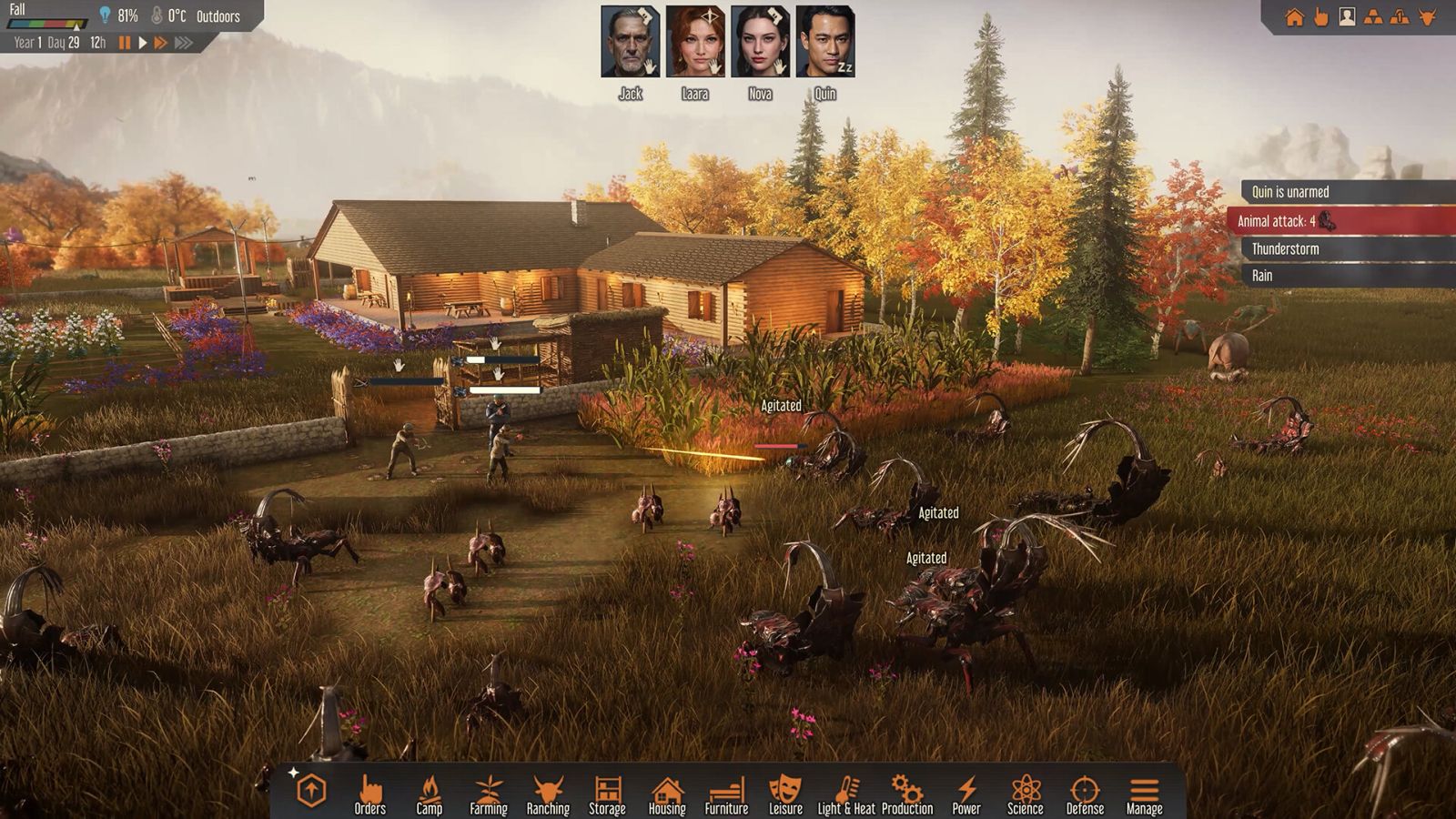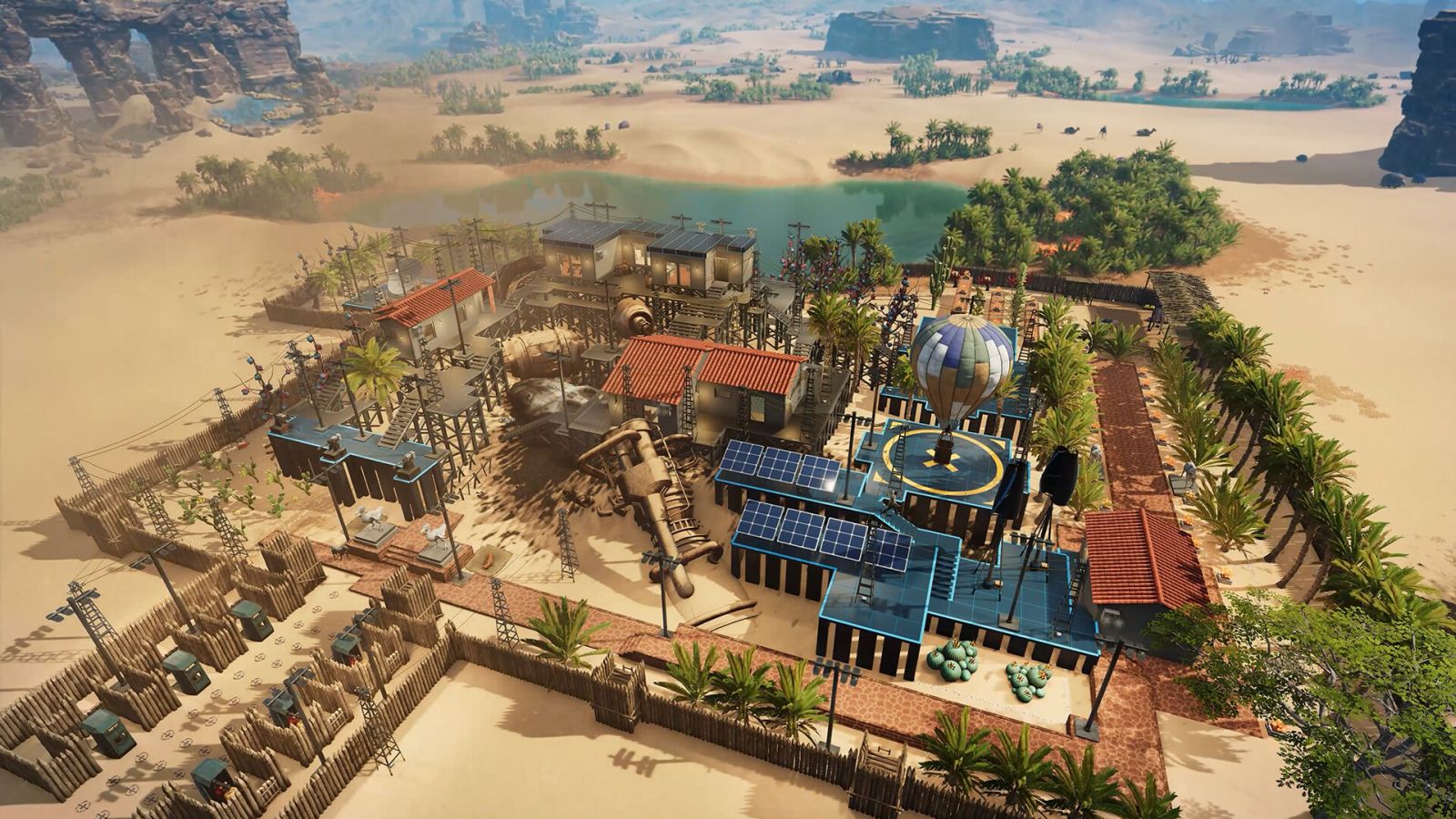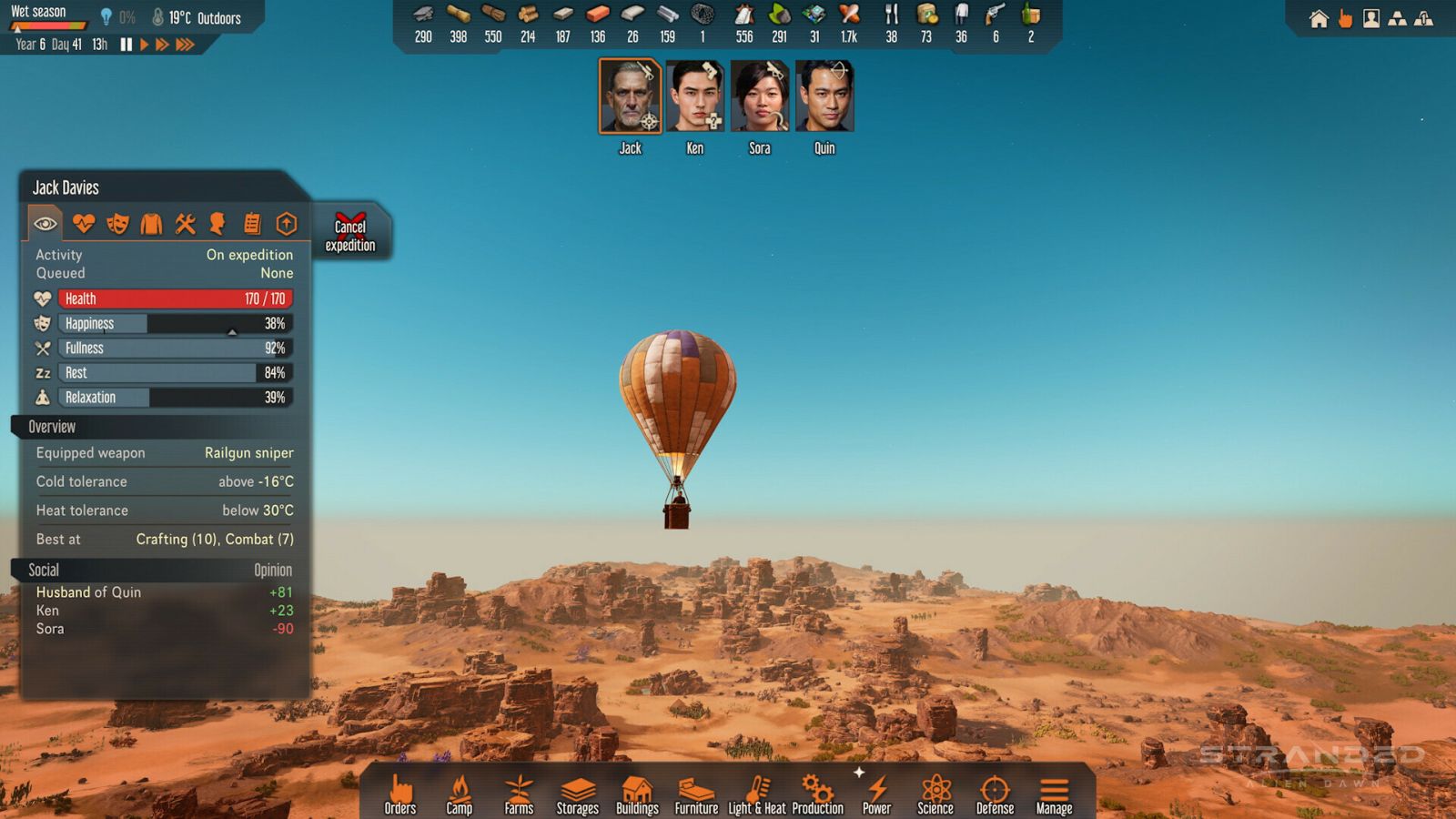
Stranded: Alien Dawn is the latest game from the team that brought you games like Tropico 3, 4, and 5, Surviving Mars, Victor Vran, Jagged Alliance 3, and more – Haemimont Games, with Frontier publishing as part of their Frontier Foundry program. An amalgamation of many tried and true formulas seen in those previous titles, Stranded: Alien Dawn has elements of base building, farming, resource management, survival, and a touch of tower defense-style combat, with a dash of crafting, exploration, and even a bit of animal husbandry. It’s a celebration of a genre that Haemimont does well, so I was eager to see what nearly a year in Early Access had refined from my previous hands-on previews.
Stranded kicks off, as the name suggests, with my crew hurtling towards an unknown planet surface, our ship disabled and on fire. While three of my crew scurried from the wreckage quickly and set about immediately trying to pick up valuable resources, a fourth member immediately had a breakdown. One of my crew saw this and headed over to comfort them back from this manic episode. Now calm, my entire team set out to try to figure out just how they’d survive in a hostile environment with no tools and no hope.
Given that your ship is more of a lander than a colony ship, there’s very little on it to help your immediate needs. Grabbing chunks of metal off of the wreckage, I was able to put up a basic shelter. It’d keep the rain off our heads, but little else. When things get cold, this simply will not do. Returning to the wreckage, one of my crew was able to recover emergency rations, but those wouldn’t last forever. Looking at my team, one of them was especially keen to tackle research activities – I sent them off to observe the nearby strange orange mushroom-like growths. Another survivor headed over to what looked like Earth pine trees with a saw – we’d have a proper shelter in no time.

Fast forward a short while and we’ve managed to put down something approaching a camp. A few lean-to structures now covered our collected resources while my crew used stacks of logs to assemble a basic log cabin-like building. Little more than four walls and a floor, it is better than something you’d see on an episode of Survivor, but additional research would be needed to make it a home. Building a research desk reveals a large list of potential improvements that can transform this outing from survive to thrive. And that’s when the insects arrived…
There are two regions at launch for Stranded: Alien Dawn — Desertum and Sobrius. Desertum is, as the name suggests, a hot desert, dry and unforgiving. Sobrius is more temperate with large meadows and regional diversity. There’s also a random button, but that’s not all that useful when you are just flipping a coin for choice.
To make things easier, there are a number of accessibility options to ease up the difficulty level a bit. Each of these toggles can help you in a variety of ways, from small improvements to downright putting the game in easy mode. For example, Big Family increases the average number of survivors you can find by 2, Eternal Bliss adds a permanent +50 to happiness, Peace First disables all aggressive animal attacks, and Random Survivors does what’s on the tin, but as a bonus all combat-capable survivors have a Railgun sniper rifle. The last two are Lost Cause which sets all of your skills to 0, regardless of their original stats, and Overqualified which does the opposite, setting them to 10 (or 6 if indifferent, 0 if they are incapable).
What does provide a bit more variety, however, is the choice of moon. You have Concordia, Jason, Nyx, and Chaos, and these might as well be a second difficulty slider. They are effectively fates that will throw challenges at you that shakes up your gameplay throughout your time on the surface. Additionally you’ll choose between three scenarios, each providing a wildly different experience. The first is the one we saw in early access — a crash landing that has you scrambling to survive after a near-fatal descent to the planet’s surface. Trading outpost casts your group of survivors as would-be traders, setting up a small trading outpost on the edges of the Outer Worlds. Their goal is to build up enough commerce to purchase the planet for themselves. The latest scenario is Military Outpost. As the name suggests, you are working to construct and defend a military outpost. Six team members are sent, and their task is to set up and build a communication array, if they can survive.

There are five difficulty levels and they affect what resources your crew will start with. I’m not certain, but I believe it also adjusts the overall aggression of the local wildlife, but that’s not spelled out in the settings. While the default is medium, easy is far from actually easy, and insane lives up to its name. Stranded isn’t an easy game by any stretch (unless you enable Overqualified – that’s practically an easy button), so know that you are probably going to fail a few times before you find your rhythm.
Picking your survivor will make a huge impact on your overall success. There are 34 survivors to choose from, and all of them have a variety of traits and skills that make each of them unique. Each will have a rating in eight skills that are important to survival. Combat, Construction, Cooking, Crafting, Farming, Healing, Intellect, and Physical can range from 0 to 10, with 0 being entirely novice, and 10 being an expert. You’ll also see a few modifiers like “interested”, “indifferent”, or “incapable”. As their names suggest, these are things that your crew will gravitate towards or away from, depending on preference. The incapable modifier means they can’t do that thing, no matter what. For example, a life as a police officer and multiple tours of duty, has left Nova Sones so withdrawn and insular that she will refuse to make decisions on her own (intellect), so you shouldn’t rely on her for that sort of thing. That said, her 6 in combat means she’ll dust most creatures with a vengeance, should she need to.
Traits are not just background, but also provide additional bonuses or drawbacks, based on their personalities. While you might have somebody who is calm, cool, and collected who won’t crack under pressure (can’t experience Meltdowns or Euphoria), they might also be Obtuse to the point where they won’t do research or observation tasks. Other traits can improve farming, provide bonuses to observation, improve the skills of those around them, calm everyone in a radius, and more. Pay attention to people’s backstory — they can often matter even more than their stats.

Speaking of research, the order you uncover technologies can have a massive impact on your survivability. The tech tree slowly unfolds, but you can see what’s around the corner. Your people can survive on basic gruel and insect meat while you spend a week researching 3D printing technologies, but their overall happiness and readiness for when waves of creepy crawlies arrive might suffer for it. Similarly, a bow and a spear might help you against minor threats, but a laser pistol will be better – provided you’ve also researched the power cells to keep them ready for use. It’s always a juggle, and making the wrong choice can have a ripple effect that can even be unrecoverable. That’s honestly one of the best things about the game, though, as each game is slightly different. What was important to your survival on run A may be completely different than run B, raising the replayability of the game. \
One of the things I appreciate is that the AI understands at least some of the production chain. They know that if they need sticks they’ll have the good sense to head over to the chopping log and turn them into sticks. They won’t see that the production chain actually starts with chopping down trees, but it’s closer to something akin to deeper AI. My hope is that eventually some survival game out there nails artificial intelligence to a level where you don’t have to manage your survivors at all, simply telling them what they need to accomplish and then leaving them to figure out the steps to accomplish it. Hey, a man can dream.
Once you’ve played for a while, you’ll also get a bit more control over your crew. Sure, you can draft them and take direct control over your survivors, but you can also get into the weeds and set priorities. You can even forbid certain people from activities, if you are inclined. Heading into the schedule, you can assign time blocks for when individual crew members relax, work, and sleep, down to the hour. This allows you to keep people who don’t get along away from one another, or keeps your towers manned in shifts, just to name a few things. As your tribe grows, you’ll likely want to set those work schedules lest you have people sitting idle.

Your people have needs, and one of them is to fill the spaces in between with something other than toil. As such, you’ll need to find ways to keep your folks busy and entertained. A dart board, a guitar, and talking to each other, admiring a statue, target practice – while it’s important to ensure bellies stay full and shelters stay safe, you’ll also need to keep your folks entertained to keep them mentally stable.
Where you crash land is likely where you’ll drop stakes and put up your eventual base. Depending on the seed and biome, you may or may not have precisely what you need laying around you. Trees, bushes, berries, and wild animals to give you protein can keep you alive for a long time. Branching out further might yield some additional resources, but it’s rarely required. The desert biome’s resources are a bit more scarce, but again they are most often relatively nearby. It’d be nice if the randomization seeds were a bit more challenging, or if you could use a slider to change the density.
Once you’ve set up a relatively stable base, it’s time to see what else exists on your planet. Building a hot air balloon will allow you to send folks out for an excursion. This vantage point will allow them to spot important resources and maybe even find other survivors. There are dangers beyond your control out there in the wilds, so you’ll be making decisions on the fly. Maybe that person you bring back won’t be a good fit, or worse, a saboteur. Maybe scrounging for resources can get your survivor hurt. Either way, you’ll have to stretch your legs a bit to see every bit of what Stranded has to offer.
Combat in Stranded: Alien Dawn has more in common with a tower defense game than an RTS. Enemies tend to charge headlong towards your base. The simple beasts will happily grind themselves to dust on your defense towers, or march through a trench trap full of flamethrowers. Combat isn’t the true focus of Alien Dawn, but more accurately described as another potential threat that you’ll have to plan against, no different than winter cold or starvation.

It’s not all sunshine and roses in Stranded: Alien Dawn. There are the occasional pathing issues where your people will adamantly seek out the dumbest way to get from point A to B, and the game provides very little in the way of feedback as to why. You’ll pull in a doorway to another secondary building only to have your crew wander out into the night to make their way to the other entrance. Then they’ll have the audacity to complain that they are cold or wet – the nerve. They’ll also complain that they can’t reach a giant stack of wood that is sitting unobstructed and in the open. Similarly, you’ll occasionally have a fierce need for winter clothing, but despite setting it as the highest priority, your people will find literally anything else to do. Survivor A is out collecting sticks and freezing to death while your resident tailor busies themselves with some idle time at the dartboard. I don’t mind that they take a little time for themselves – I mind that I don’t have any good indicators as to why.
One of the ways that you can actually mess up your own survival game is to overload your folks with things to do. Your minions are smart enough to not set themselves on fire, but they don’t handle prioritization very well. If you set up a ton of farming, then stack on hunting, then ask them to move berries from the shelf to the fridge, and then queue up sewing a beanie hat, you’ll find that all of these tasks are taking forever. Your survivor is very likely to start some or all of these tasks and slowly push all of them a percent at a time rather than focusing and getting any one thing done quickly. For as much control over some aspects of the AI Stranded offers, there are still some portions around prioritization that are still a bit of a black box.
A recently released roadmap reveals some adjustments to all scenarios and maps, as well as additional post-launch content. Haemimont has never been shy about releasing new goodies after their game launches, but the information they’ve announced so far is a little thin on the ground. On the surface, it’d be easy to compare Stranded to games like Rimworld, but that’s not a fair comparison. Rimworld offers a practical universe of opportunities, whereas Alien Dawn tries to offer fewer but more developed choices. That’s not a knock on what Haemimont has accomplished here, but we might have to see a roadmap that stretches a little further in the distance to ultimately see where Stranded: Alien Dawn will land post-launch. Right now the lack of scenarios can feel a little thin on the ground, with the variety of survivors and the randomness of events providing variety on a second or third run.

Without spoiling some of the endgame, what you see in the tech tree is far from where that tech tree ends. There are some fairly big (and I mean BIG) surprises to be revealed later on. The moment when the game clicks over from survive to thrive, you’ll suddenly realize that you’ve been playing the game for a few dozen hours. I know I certainly did! I also found myself saying “next time I’m going to…” which speaks to the replayability of the game. Be brave – hit the random button and don’t lean on the cheats. Overcoming the completely random dangers and turning them to your advantage provides a feeling of real accomplishment. Sure, it’s freezing and awful outside, but when you have an interconnected base with thermal protection and hydroponic crops, you know you’ve beaten what this savage planet has to offer. Watching my time crash landed on this alien world come to an end felt less like the end but more like a beginning. Taking what I know now, could I do better next time? Would a brand new cast of survivors upset the whole thing to the point where it might go even worse? It’s nice to find a game that makes me want to find out.
Stranded Alien Dawn
Great
Stranded: Alien Dawn is a well-focused survival game with choices that have meaningful and lasting impact. While it could stand to have a few more scenarios, what’s on offer will keep you busy for dozens of hours, and that’s just your first playthrough!
Pros
- Choices with real lasting impact
- The world is legitimately dangerous and unpredictable
- Enough randomization to keep things interesting
- A few surprises that aren’t immediately obvious
- Accessible, with many options to tweak difficulty
Cons
- Pathing issues can be frustrating
- Could use more scenarios
- Biomes are rarely worth exploring in detail
